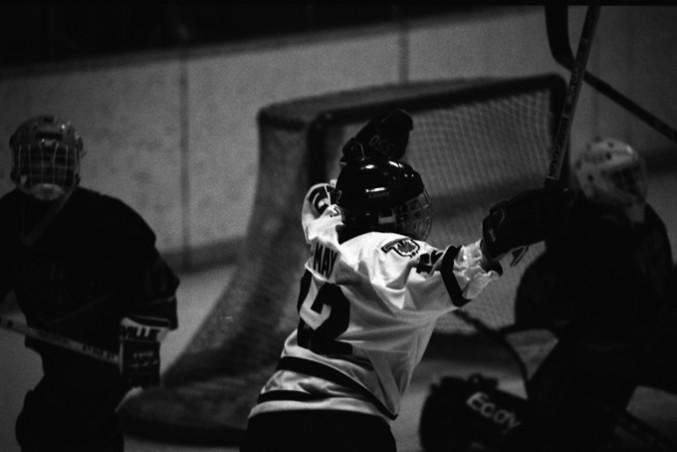Hockey has surged in popularity with women over the past decade, despite being more than 100 years old. PHOTOS: TOM SAPIANO
By Jeffrey Ferrier
Moss Park Arena. Two minutes to go in the third period. The home team trails by three goals.
The home team’s centre carries the puck across the blue line. The wingers follow. They skate to the front of the net. The centre passes the puck to the post. A shot. The goalie stops it.
But there’s a rebound. The left winger muscles past the visiting defence and picks up the puck.
She shoots…
Conrad is one of an increasing number of women who play ice hockey. The sport, though more than 100 years old, has surged in popularity with women over the past 10 years.
Canadian Universities have taken notice and many, including six Ontario schools, have set up women’s hockey teams. The best women’s teams converge in Toronto this weekend at Varsity Arena for the CIAU Women’s National Championship.
But Ryerson won’t be represented. That’s because the school has no women’s hockey program.
“I went on an athletics tour of Ryerson,” Conrad remembers of her high school days. “I asked why Ryerson had no women’s hockey program. The guide said, ‘Ryerson has figure skating for the women. Hockey is for men.'”
Women’s hockey has come of age during the ’90s. In the past decade, the International Olympic Committee made women’s hockey a medal sport. Manon Rheaume played an exhibition game in goal for the NHL’s Tampa Bay Lightening. And more and more Canadian universities have started to think about starting varsity women’s hockey teams.
Todd Erskine, a fourth-year Brock University student, is leading a drive to bring varsity women’s hockey to his school. But it hasn’t been easy.
“Our athletic department supports the idea,” Erskine says, “but hockey has a large budget. And Brock isn’t prepared to take on that budget.”
So what Erskine has done is organize a team made up of players from Brock’s women’s intramural league. The team plays against senior women’s teams from the Niagara area.
Women first played hockey in 1892. Lady Stanley attended women’s games two years before her husband donated the fabled cup that bears his name to men’s hockey.
The sport his the university scene in 1896. Women at Queen’s University defied the school archbishop and formed the Queen’s Love-MeLittles.
From then until 1930, inter-university play flourished. The women wore wool sweaters, gloves, toques and long skirts. Resourceful goalies knelt on the ice and lay their skirts across the goal line to keep the other team from scoring.
Cash-strapped universities abandoned women’s hockey in 1933 because of the Great Depression.
The game slowly started to recover during the ’60s and today is more popular than ever.
Although the idea of women’s hockey has started to grow at Ryerson on the intramural level, it is a long way from reaching the plateau of varsity competition.
“Any program that gets going at Ryerson gets going when students demonstrate an interest in that program,” Chuck Mathies says. “I need to see some demonstrated interest there.”
To prove the interest is there, Mathies says students would have to set up a successful women’s intramural hockey league to convince him. And even then, he’d still want to see if the school could support a team like the one at Brock before he would advocate setting up a women’s hockey team.
“Right now, there’s no individuals coming forward. Just a handful of players playing intramurals,” Mathies says.
The buzzer sounds at the old armoury rink at Shuter and Sherbourne streets. The game ends. Jessica Conrad’s team loses to its male opponents. But if interest keeps growing, female hockey players at Ryerson may win the chance to play in the OUA.

















Leave a Reply